15 gold-standard experiences you must have in Paris
In a city that scales the Tour Eiffel-like heights of life’s greatest pleasures – food, drink, art, culture, architecture, design, fashion, shopping, beauty – it’s no wonder that the popularity of Paris endures through good times and bad.
The City of Light is once again one of the world’s most visited cities, wooing more than 44 million tourists last year, a figure almost back to its pre-pandemic levels.
Whether you’re a Parisian debutant or a repeat visitor, “The City of Light” promises moments of travel magic that’ll illuminate your trip and linger with you long after you fly home.
We refer to that first, giddy glimpse of the Eiffel Tower and those incroyable paintings at the Louvre. We’re thinking of the scents and crunch of those warm, just-baked croissants and baguettes from that corner boulangerie humming with Parisian chatter (“Bonjour madame”, “Merci monsieur”).
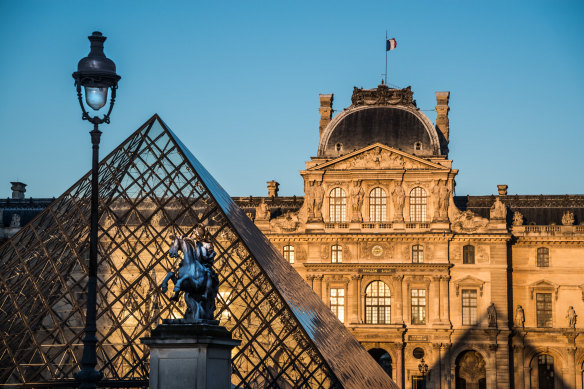
The Louvre.
Then there’s the simple joy of indulging our inner flaneur, striding along elegant Haussmannian boulevards and down quaint, cobbled alleys where that cute Michelin-lauded bistro tantalises with a prix fixe lunch (and maybe a glass of wine or two).
Well accustomed to effortlessly flaunting its treasures, Paris is preparing for extra time in the global spotlight.
For starters, it’s one of nine French cities staging matches for the 2023 Rugby World Cup (September 8-October 28) before taking centre stage as host of the 2024 Summer Olympics (July 26-August 11) and Paralympics (August 28-September 8).
Years in the planning, these spectacles have sparked a flurry of new developments, from pop-up arenas and better transport infrastructure to celebrity-backed hotels and hangouts set to cash in on the additional tourist influx (for the Olympics, between 12-15 million visitors are expected).
Although 6.8 million tickets have already been sold for the Games there’s still some availability, not just in Paris, but for events staged in other French cities, such as sailing and football in Marseille and handball and basketball in Lille.
Whether you’re coming for that, or planning a trip later on, you can embrace your own Parisian adventure in Traveller’s special Olympique-inspired guide to the beloved French capital.
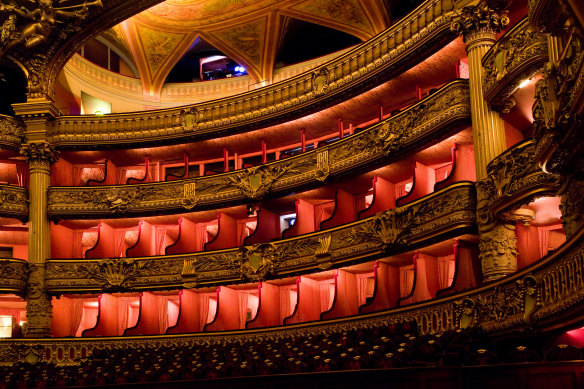
The Palais Garnier, also known as Opera Garnier.
You may not win any medals, but golden experiences await across this endlessly rewarding city.
Opening ceremony: L’arrivee
Welcome to the 2024 Olympic host city. Sporting sleek, revamped terminals, with fancier lounges, retail and dining, Paris Charles de Gaulle (CDG) is likely to be your first (air)port of call. Europe’s third busiest passenger airport after London Heathrow and Istanbul is 25 kilometres north-east of central Paris.
You’ll pay about €50-60 ($82-98) for a ride into town from one of the dedicated taxi ranks outside the arrivals gates (ignore unsolicited offers inside the terminals).
Public transport from CDG includes the RoissyBus shuttle, which drops you at Opera - near the Palais Garnier - in about an hour (€16.20 one way).
A bit quicker is the RER B train (€11.45) connecting the airport with city stations like Chatelet-les-Halles - a huge underground hub that links to five Metro lines - and Gare du Nord, which is also, incidentally, where you’ll arrive if coming to Paris on the Eurostar from London instead.
The village: Les hotels
From grand dames flaunting facelifts to attention-seeking starlets, Paris has more potential bases than ever.
Two of the coolest hotel openings of 2023 have been shaped by top New York and London-based Swedish architect Martin Brudnizki. There’s La Fantaisie, a plant-flush retreat with a rooftop bar near Palais Garnier, and the chic Le Grand Mazarin in Le Marais.
That district is now also home to Maison Proust, a dashing hotel inspired by the revered Parisian novelist with interiors by legendary French designer Jacques Garcia.
Cycling: Tour de Paris
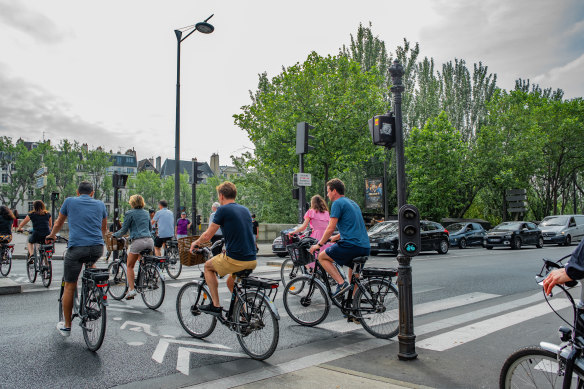
Road changes have been a boon for cyclists.
For years cycling in Paris was synonymous with the Tour de France, and the race’s ceremonial finish on the Champs-Elysees.
But cycling for regular people has well and truly properly taken off in a newly green-minded, pre-Olympics Paris, with more than 1000 kilometres of bike paths now coursing through the city and surrounds.
There are new dedicated lanes to the Stade de France, the soon-to-be Olympic Stadium in the northern suburb of Saint-Denis (France’s biggest sporting and music venue offers behind the scenes tours).
Evoking the language of the French Revolution, some motorists have accused Anne Hidalgo, Paris’ eco-conscious mayor, of wielding a “reign of terror”, but Parisians and tourists alike have relished her drive to shunt vehicles off the roads.
You can now, for example, ride past the Louvre and Jardin des Tuileries in virtual car-free peace on the once-congested Rue de Rivoli; breeze through formerly fume-clogged tunnels by the River Seine, and pedal on segregated bike lanes through hip and happening enclaves like Pigalle and Bastille.
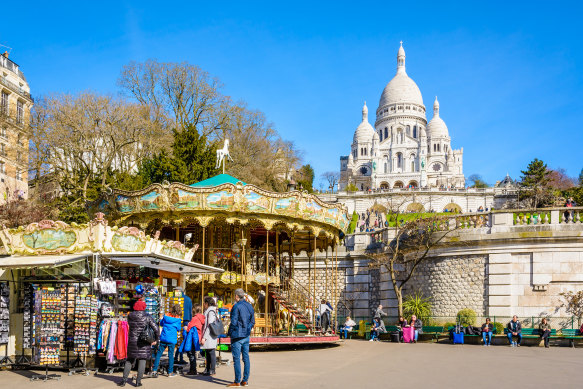
Carousel below the Basilica of the Sacred Heart.Credit: iStock
Join a guided, history-spliced Paris cycling tour near the Pompidou Centre, or hire wheels independently, standard or electric, from the Velib bike-share scheme, which has more than 1400 docking points in and around the city.
Walking: Paris, step-by-step
You could tick off your 10,000-plus daily steps in the Louvre alone. There are 14 kilometres of corridors and rooms in this former fortress and royal palace, but the crowds and artistic distractions, from the Mona Lisa to the Venus de Milo, make it difficult to hone your race-walking technique.
Better to stretch your legs outside, with Paris’ sight-blessed parks, boulevards, stairways and quais (riverside paths) brimming with pulse-spiking possibilities.
You could spend hours roaming the Left Bank’s Latin Quarter, breaking at its bookshops and literary cafes, patisseries and produce markets, or getting lost in the atmospheric, 44-hectare Pere Lachaise Cemetery, resting place of Edith Piaf, Oscar Wilde and Jim Morrison.
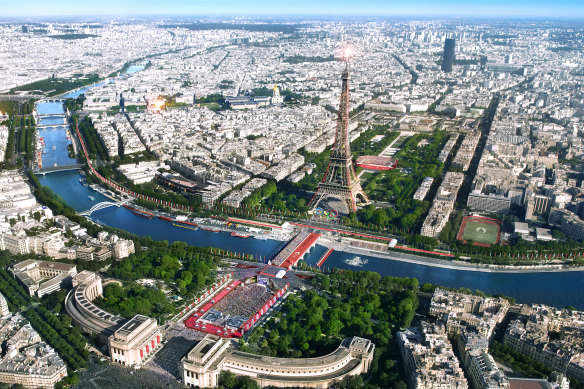
A digitally altered rendering of what the 2024 Paris Olympics may look like.
As part of the “Paris Breathes” project, some city districts are almost entirely closed to vehicular traffic on Sundays and public holidays, notably Montmartre and Le Marais. And on the first Sunday of the month, the Champs-Elysees is pedestrianised.
This two-kilometre avenue is book-ended by the Arc de Triomphe and Place de la Concorde, with its mighty Egyptian obelisk, and flanked by other resplendent landmarks, such as the Grand Palais and Petit Palais, a pair of Belle Epoque beauties built for the 1900 Paris Exposition.
The former will host the Olympic fencing and taekwondo. The latter houses the city’s fine art museum – one of several unsung, admission-free Parisian cultural attractions. Others include the Museum of Modern Art, in the Palais de Tokyo, and Victor Hugo’s house by Place des Vosges, Paris’ oldest planned square.
Swimming: Eau for a dip
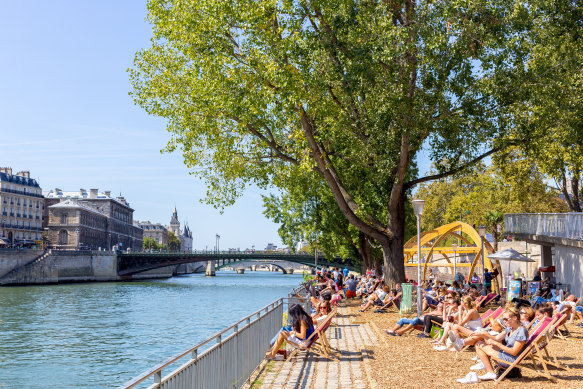
Cooling off by the Seine.Credit: iStock
Swimmers raced in the Seine at the first Paris Olympics in 1900, but by the second Paris Games in 1924, the river had been deemed so filthy that bathing was outlawed.
A major resuscitation of the Seine is under way ahead of 2024. Not only will the Olympic opening ceremony be held by and along the river, but marathon swimmers and para-triathletes will compete in the cleaned-up waters.
In 2025, three lifeguard-monitored public bathing zones will open, bracketed off from the Seine’s boat traffic.
Until then, work on your breaststrokes and butterflies in the 13th arrondissement. As well as Piscine Josephine Baker, a “floating” open-air 25-metre pool on a barge by the Seine’s Left Bank, there’s the art nouveau-tinged municipal swimming pools of Buttes-aux-Cailles, a quaint, hilly, cobbled enclave that has an air of Montmartre but barely any tourists.
You’ll also find pools at many Parisian hotels, including the Molitor, a funky retreat set around former public swimming baths. It made a splash in season three of Emily in Paris.
Weightlifting: Boutique blitz
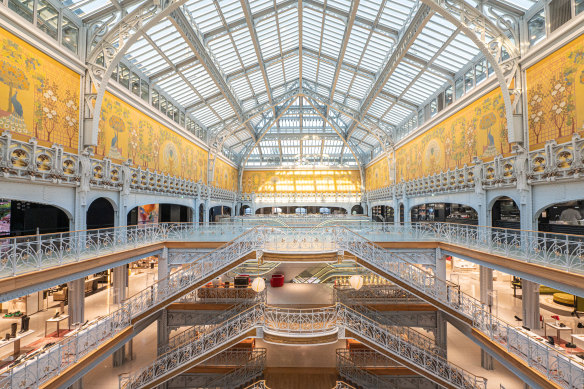
La Samaritaine Paris.
Bulging muscles are a given on a Parisian shopping spree. You’ll probably be weighed after a few hours at glamorous department stores like La Samaritaine and Galeries Lafayette.
Aromatic aisles gleam with enviable clothes, shoes, bags, jewellery and perfumes from major brands and emerging labels.
Be sure to glance up at the decorative flourishes and ornate glass ceilings. Galeries Lafayette even has a roof terrace, where you can take a breather with bubbly, lunch and a Parisian panorama starring the Eiffel Tower and Montmartre’s Sacre Coeur.
Prefer boutique shopping? Check out the sparkling luxury stores on Avenue Montaigne, off the Champs-Elysees, or Rue Royale and Rue du Faubourg Saint-Honore behind the Elysee Palace (official residence of President Macron).
If independent concepts and fashions are more up your street, try Rue du Chateau d’Eau, close to Place de la Republique, and home to gems like Mamasushi, a slow-fashion doyen, homewares haven La Tresorerie and Sergeant Paper, which sells retro prints and posters of Paris and other dreamy destinations.
The marathon: Michelin accomplished
For the first time in Olympic history, ordinary mortals are being invited to run the Games’ marathon route, following the exact 42 kilometres Paris-Versailles loop that the Olympic athletes will compete in a separate race.
Over 20,000 amateur bibs are up for grabs, but to qualify, you’ll have to jump through hoops, gaining points beforehand from sporting activities, games and quizzes.
It may be easier to tackle another kind of marathon altogether – a dining degustation at one of the city’s temples of gastronomy.
Settle in for an 11-course seasonal “land and sea” tasting menu (€490) at Alain Passard’s L’Arpege, a three-Michelin-star restaurant near the Rodin Museum or the almost-as-long €440 degustation at Epicure.
Helmed by chef Eric Frechon, this three-star affair graces Le Bristol hotel, a Parisian institution that counts Charlie Chaplin, Sophia Loren and George Clooney among past guests.
A little friendlier on the wallet – think: seven courses for €195, a three-course lunch for €95 – the one-Michelin-star restaurant of Anne Sophie-Pic is just north of the Louvre.
It serves inventive dishes like Mediterranean octopus with Japanese barbecued zucchini and Vietnamese coriander, and Normandy veal chop with artichoke and seaweed.
Tennis: In the court of champions
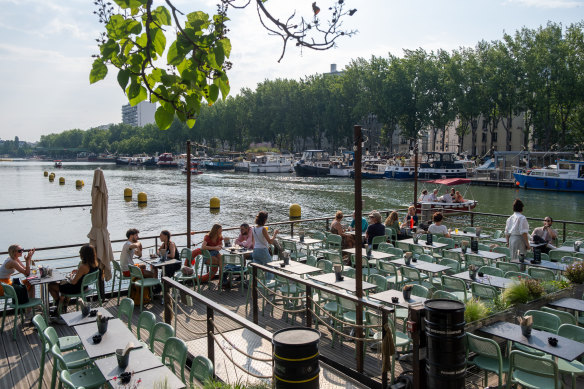
Paname Microbrewery.
The Molitor is a handy base for the tennis, just a short serve from Stade Roland Garros, where the Olympic tennis will take place and where Rod Laver, Ken Rosewall, Evonne Goolagong Cawley and Ash Barty are among Australians to clinch French Open championship glory.
Go behind the scenes on a 90-minute guided stadium tour that’ll take you from the locker rooms to the Court Philippe-Chatrier, where Rafael Nadal is the all-time “king of clay”, winning a record 14 French Open titles.
You may be keen for a game afterwards. Sign up with Paris Tennis to hire municipal courts across the city for €20 an hour
Choose from a variety of settings, from the urban (the rooftop Atlantique courts by Montparnasse station) to the leafy (the artificial grass and concrete courts in Bois de Vincennes, Paris’ largest park, on the city’s eastern limits). If you haven’t packed your racket, Decathlon has several Paris outlets.
Equestrian: The mane event
Enjoy a horseback ride in Bois de Boulogne, just north of Roland Garros and western Paris’ answer to Bois de Vincennes.
Originally hunting grounds for French royalty, this gigantic green lung has 28 kilometres of trot-friendly trails threading by woodland, botanical gardens and boating lakes.
Also good for joggers, strollers and cyclists, this park has restaurants and galleries, including Fondation Louis Vuitton, a contemporary arts space in an eye-popping Frank Gehry-designed landmark.
South-west of Paris, you can also saddle up on the estate of the Chateau de Versailles, where Olympic and Paralympic equestrian events will be held.
Afterwards, have a nose around the ostentatious palace and see where the “Sun King” Louis XIV lived, frolicked and feasted. You must book a ticketed time slot in advance.
This UNESCO-protected palace is one of France’s most visited attractions and celebrates its 400th anniversary this year.
Closing ceremony: Au revoir, Paree
It’s a wrench bidding farewell to Paris. You’ll get over it, but how quickly depends on where you’re headed next and whether or not it has to be home.
If you’re hanging around, high-speed trains whistle across the country – to other engaging French cities like Lyon, Bordeaux or Aix-en-Provence, and over the border to Amsterdam, Brussels, Barcelona, Cologne, Geneva, Milan and others.
You could hire a car and road trip it east to the Loire Valley sublime pocket of countryside bubbling with chateaux and vineyards. Alternatively, venture west to the Champagne region, or south to the unspoiled, hiker-friendly highlands of Massif Central.
Perhaps the most enchanting way to leave Paris is on a cruise ship. River cruises, operator by lines such as Scenic, Viking and Avalon, drift up the Seine via ports painted by Claude Monet, including the cathedral city of Rouen, his lily-pond-tickled gardens at Giverny and the postcard-pretty harbour town of Honfleur. From there you can set out for the D-Day landing beaches, the chalk cliffs of Etretat and a nourishing cider and cheese-tasting trail Normandy
See paris2024.org
Five more things to do and see in the Olympique City
Climbing
The Eiffel Tower has 1665 steps, and you can scale 674 of them between the ground floor and the second-floor viewing platform. You’ll have to take a lift to reach the very top. For another terrific vista, climb the 270 steps up the hill to the Sacre Coeur, then another 300 steps to the basilica’s dome.
Artistic gymnastics
Jaw-dropping, limb-bending routines are a speciality of the Paris Opera Ballet which has been staging productions since the reign of Louis XIV. There are two main venues for its shows: the Palais Garnier, a ridiculously lavish 19th-century opera house immortalised in Phantom of the Opera, and the Opera Bastille, a modernist 1989 venue.
Canoeing
You can rent canoes, kayaks and paddleboards at Bassin de la Villette, an artificial lake by the canals in north-eastern Paris. Also here in summer are outdoor pools for Paris Plages, a program of pop-up “beaches” on the city’s waterfronts. Dry off with a craft beer at the canalside taphouse of the Paname microbrewery.
Wrestling
This is Paris, so there’s always the chance of strikes, demos and, yes, the odd riot. Citymapper helps navigate Paris’ labyrinthine transport network and even if you do wrestle with French do know the phrase, “Bonjour, parlez-vous anglais” (hello, do you speak English?) Many Parisians do, but they appreciate it if you try to speak their language a little.
Boxing
Take out any possible, nay inevitable, Parisian frustrations on the punch bags at Le Hall Boxing, a boxing club offering classes in Belleville, birthplace of Edith Piaf, whose great love was Marcel Cerdan, one of France’s greatest-ever boxers. Post-workout, hit Moncoeur Belleville, a trendy brunch spot with a panoramic terrace.
Sign up for the Traveller Deals newsletter
Get exclusive travel deals delivered straight to your inbox. Sign up now.